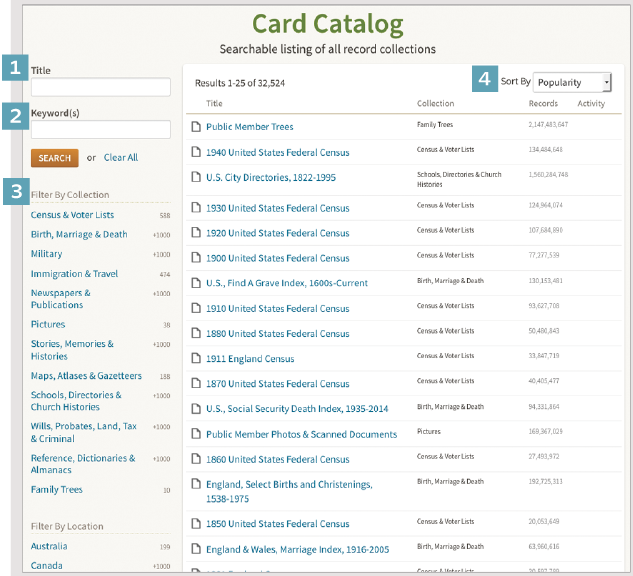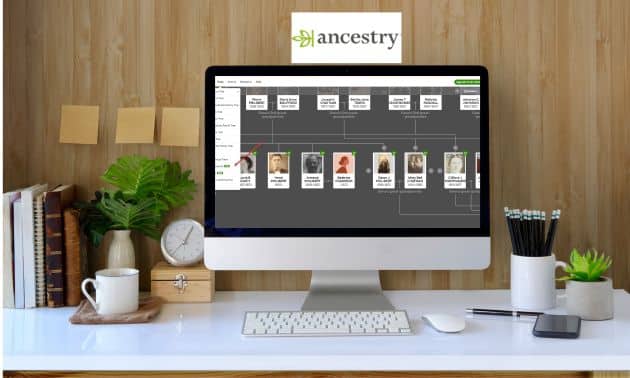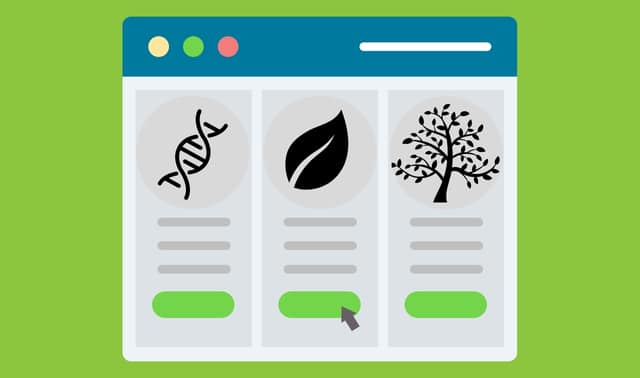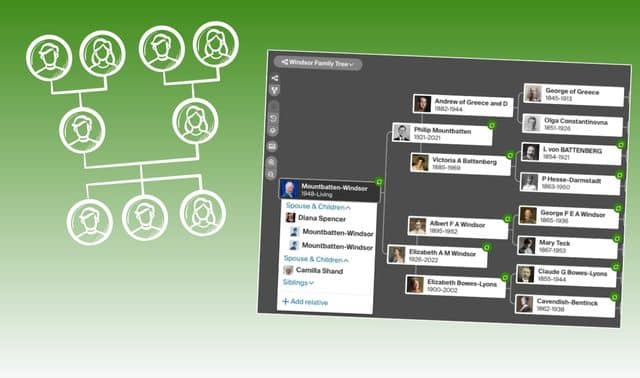Sign up for the Family Tree Newsletter Plus, you’ll receive our 10 Essential Genealogy Research Forms PDF as a special thank you!
Get Your Free Genealogy Forms
"*" indicates required fields

Genealogy website Ancestry.com is something like a giant shopping mall. Though a mall’s outside might give the impression of a single enormous store, it’s actually home to dozens of smaller shops. Frequent shoppers make a beeline for their favorite places: the big department store, certain specialty shops and maybe the Orange Julius stall in the food court.
Similarly, Ancestry.com can at first appear to be a single enormous database of ancestral records. But in reality, its card catalog boasts more than 32,500 individual collections of records. Regular visitors to the site (whether using a subscription from home or Ancestry Library Edition for free at a public library) quickly discover their favorite databases, often the ones with broad coverage that turn up frequently in search results: census records, family trees, draft registrations. Genealogists may find it easy to ignore other collections, even though they may offer exactly what the shopper wants.
Here, we round up nine of our favorite “boutique” collections on Ancestry.com. These databases can outfit your ancestors with records you had no idea would fit them. In some cases, they can help you make over your impression of their everyday lives. Your discoveries even can lead you to new records shopping experiences outside this genealogical Mall of America. So imagine yourself looking at a map that says “You Are Here” and start plotting your next route through Ancestry.com. Sorry, though—you’ll have to find your Orange Julius elsewhere.
US City Directories
With more than 1.5 billion records, US, City Directories, 1822-1995 is the largest set of original records on Ancestry.com. It’s more than 10 times the size of the Find A Grave or 1940 census database. (The only larger collection is user-submitted public member trees.)
Every state except Alaska is represented in the collection, plus the District of Columbia. Twenty-six states have directories for more than 20 cities or counties. Not all places had directories published every year, and not all those that were issued made it to microfilm or to this digital collection. Coverage for big cities, though, is exceptionally thorough. To see what’s available for a city, look under the “Browse this collection” on the right and choose a state and city or county.
Many states have a catchall “various” category among available places. For Indiana, this includes four years’ lists of businesses throughout the state from the 1860s and 1870s. These may help locate an ancestor or paint a quick sketch of the tiny town she came from. But to find material like this, you’ll have to browse the entire directory, not search. (In the record viewer, you can page back and forward individually or jump pages using the filmstrip across the bottom.)
In addition to the usual search fields, you can use keyword searches to find names, addresses (handy for finding everyone who lives at a particular address) and businesses.
Land Office Records
Most land records are kept locally, but some of the most exciting ones are in a nationwide database of patent records. Patents were created when a settler or speculator bought land directly from the government—the land’s original transfer into private hands. In US, General Land Office Records, 1796-1907, Ancestry.com has about 2.2 million patents for 14 states (Alabama, Arkansas, Florida, Illinois, Indiana, Iowa, Louisiana, Michigan, Minnesota, Mississippi, Missouri, Montana, Ohio and Wisconsin) up to 1907. These represent a significant portion of what’s on the free General Land Office (GLO) website, which has about 5 million records covering 49 states and the District of Columbia with more recent coverage.
Why search the partial Ancestry.com database when the entire GLO database is free on its own website? While GLO allows searches with wildcard characters as substitutes for one (use a ?) or more (an asterisk, or *) letters in a name, Ancestry.com offers more search flexibility for the names it does index. For example, a search for Baldwin on Ancestry.com includes a Mr. “Baldwyn” and a man by the first name of Belton in its results. Whenever you can search valuable databases from more than one search engine, you should do it—each may give you unique results. From the results on either or both sites, you can download the land patent and decide whether to order the full land entry case files from the National Archives.
Land Ownership Maps
Nearly 1,200 county land ownership maps from the Library of Congress are indexed in US, Indexed County Land Ownership Maps, 1860-1918, which is linked to images of the original maps. Just under 7 million names appear on maps from 34 states. The Northeast and Midwest are much better represented than the South and West. Nineteen states have more than 15 counties and years represented: Illinois, Indiana, Iowa, Kansas, Kentucky, Maryland, Massachusetts, Michigan, Minnesota, Missouri, Nebraska, New Jersey, New York, North Dakota, Ohio, Pennsylvania, South Dakota, Washington and Wisconsin.
Search this collection by name, residence, year and keywords, or browse the maps by state and county. Owners listed on various parcels may appear more than once. It’s fair to warn you that some maps are mislabeled or misindexed. Be sure to double-check the results against other contemporary maps and original land records, such as deeds and patents, when possible (especially if your findings seem confusing).
Having fun with this database? Search Ancestry.com’s related collection with earlier maps, US, Indexed Early Land Ownership and Township Plats, 1785-1898.
Tax Assessment Lists
As if the Civil War weren’t enough trouble, the federal government passed the first Internal Revenue Act on July 1, 1862. Not everyone was assessed, just those who met income requirements.
It’s too bad for them, but good for you, because the nearly 9 million records in the US IRS Tax Assessment Lists, 1862-1918 database may help locate a person in a specific place and time, or at least where he or she owned property. With luck and careful study, you may learn something about wealth or occupation.
This database includes 36 states and the District of Columbia, with one-quarter of the records coming from New York state. Almost all data are for the Civil War era and a few following years, but four states have records going up to 1918: Arizona, Colorado, New Mexico and Wyoming.
Because these records are organized by Congressional district within states, searching for a county won’t work. Instead, search with a name and narrow the place to a state, if you know it. Once you land on a particular page, you’ll see that the tax collector recorded town names (which can give a clue as to where in the state the person owned property).
Curious how severely taxes pinched your ancestors’ wallets? Learn more about the value of money over time at Measuring Worth. Use this website when you start perusing the next collection, too.
Sears Catalog
You won’t find a single ancestor among the pages of the Sears catalog, unless he or she modeled the wares. But in Historic Catalogs of Sears, Roebuck and Co., 1896-1993, you’ll find the everyday objects that filled their lives and fueled their daydreams. This popular mail-order catalog reached even the most rural consumers. Multiple price points for common objects (good, better, best) had wide appeal.
How can you use the Sears catalog to enrich your family history research? Browse its pages from your grandmother’s childhood or a great-grandparent’s adult life. Look for items your relatives owned or likely owned: clothing, shoes, watches, jewelry, sewing machines, musical instruments, baby carriages, bicycles, toys, dolls, kitchenware and more. (The popular Sears kit houses, which included all the materials to build a home, appeared in a separate Modern Homes catalog. Find many of these catalog pages in the online Sears archive.)
Keyword searches of these catalog pages are more effective beginning in 1900, but they still don’t catch everything. (Read why on the opposite page.) Browsing is best—and it’s also fun. You might never think to search for “obesity powder,” but you might be intrigued to stumble upon the stern lecture in its description, especially if a photo of Grandpa in 1901 shows him to be a bit portly. Some catalog issues are indexed; browse the first few pages to find the index or a reference to it (such as “see pink pages in middle of catalog”).
Interviews with Former Slaves
In the 1930s, more than 2,300 former slaves recounted their memories to government workers who recorded them as part of the Works Progress Administration. Interviewers asked about their experiences in slavery, from the quality of food they were given to how they were treated. Interviewees also gave opinions about slavery as an institution and about other historical and then-current topics. WPA workers compiled the typescripts with some photographs into volumes by state.
The Ancestry.com index called US, Interviews with Former Slaves, 1936-1938 points to those digitized volumes. Search for individuals by surname, with the understanding that finding an ancestor among the interviewees is a longshot. Scroll down on the search page to narrow your search by the interviewee’s birthplace and even where each parent lived (if known). Next, skip the name field and try searching for a narrative by someone born in the same place or in the same year as your ancestor.
Though this collection of interviews provides invaluable first-hand testimonials, it also has some limitations. Memories were more than 60 years old when the interviews occurred. Some interviewers didn’t transcribe conversations carefully. Interviewees were less candid when speaking with white interviewers, some of whom were descended from former slaveholding families. Learn more about the ins and outs of this important historical collection at the Library of Congress’ Born in Slavery site.
Quaker Meeting Records
Nearly 6.5 million names appear—and even more people are hidden unindexed—in US, Quaker Meeting Records, 1681-1935, Ancestry.com’s collection of Society of Friends (Quaker) church records. Representing 20 states, the District of Columbia and areas outside the United States, these records cover 250 years of Quaker life.
The Quaker faith is best known for living simply, opposing war and slavery, and supporting women’s rights. Members’ monthly meeting minutes keep track of their transfers between congregations, marriage intentions, disciplinary measures and requests for church burials. They also kept separate registers of births, marriages and burials.
Search among indexed names with a location and event, or browse the records by state, county, monthly meeting (a congregation, usually referred to with a place name) and record type. The latter is a great option if you think a relative may have attended a Quaker marriage (all witnesses to marriages appear in the records, but those names weren’t indexed for this collection) or may have been involved in church activities.
Be sure to read the database description, which includes several tips to help you better use these records. For example, Quakers recorded dates in a distinctive way and their societies had a major split in 1827 that affected record-keeping.
Quakers aren’t the only faith you’ll find indexed on Ancestry.com. The Dutch Reformed Church and growing numbers of Methodists (mainly in the Midwest) now appear in multiple collections, for which you can search the card catalog (an option under the Search menu) by keywords Dutch Reformed or Methodist.
School Yearbooks
The collection of US, School Yearbooks, 1880-2012 now has nearly 360 million indexed names from middle and junior high schools, high schools and colleges from the United States and beyond. In addition to that headshot (whether adorable or awkward), you also might find your relative pictured with the football team, yearbook staff, school spirit club or prom court. Maybe you’ll learn how his football team fared that year. Fads, fashions, local history, world events and other interesting trivia are often scattered throughout the books.
Search first by name, then by only the surname if needed (perhaps your relative went by “Butch” that year instead of John). If you don’t find a match, browse by state, then city, school and year (if you know these) to see whether the
collection includes your relative’s yearbook. Remember that someone may have attended school in a suburb, in the city or another location you’re not expecting. Try a surname search for a few years before and after your target date range, in case you can locate siblings in yearbooks. (If the family didn’t move, a sibling’s appearance in a yearbook may indicate that you’ve at least got the right school.)
If your relative enlisted after high school, you may want to look for Ancestry.com’s military yearbooks, too. You’ll find the database at US Navy Cruise books, 1918-2009.
Voter Registers
California, Voter Registers, 1866-1898 represents only California, but it’s instrumental to the many researchers to whom it seems as if someone tipped the map in the 1800s and all their ancestors slid west to California. This database is an interesting way to find the ones who voted.
Coverage includes 3.7 million records from 56 of the state’s 58 counties, and most years are covered in most counties. Gaps in holdings are clearly noted for each county, making it easy to see whether a failed search is evidence of absence of the person or of records.
Frequently created records like these tend to be sparing with personal details. But some years have a windfall of information—some San Francisco registers have the voter’s name, age, birthplace, occupation, address, and date and place of naturalization. Some records include political affiliation. What these records may lack in detail, they make up for in frequency. You could track the same person from residence to residence for 30 years.
These records take some getting used to. Usually more than one annual register is in a single batch. You may need to page back and forth to find the beginning of each election year’s publication. Two seemingly identical hits in the index usually indicate registers from two different years.
Remember to follow up on these records by searching for ancestors in relevant court records, city directories and newspapers for these locations. See a smaller related collection for later years: California, Voter Registrations, 1900-1968.
We hope this quick guide to some of the excellent “boutique” collections on Ancestry.com will encourage you to broaden your shopping—er, search—habits at this ever-growing online mall of genealogy records.
How To Find Specific Collections on Ancestry.com

The key to finding relevant individual record collections on Ancestry.com is to search its Card Catalog, which you can access from most pages on the site by clicking Search, then choosing Card Catalog from the drop-down menu.
1. Search with a title if you know the name of the collection you want to search.
This isn’t always successful, as the search isn’t flexible at all—your search terms have to exactly match words in the title.
2. Searching with one or more keywords is often the fastest route to records collections you’re after.
Enter terms such as Massachusetts divorce or slave. This will bring up results that have those terms in the title or description of the collection.
3. Filters let you narrow your search results by type of collection (such as census, military, immigration, etc.), location, dates covered, and language.
Use any combination of filters. Browsing this way has some advantages over keyword searching because you get to see related databases that may prove helpful.
4. Sort your results by popularity, alphabetically by title, by date Ancestry.com added or updated the collection, or by size of the collection.
ADVERTISEMENT




